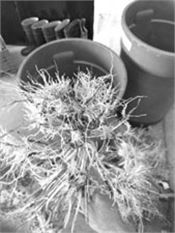Assessing Corn Rootworm Damage – Now Is The Time

Don’t wait until this point to learn you had a rootworm problem.
DR. NICK SEITER
URBANA, ILL.
Corn rootworm activity, in general, appears higher in much of Illinois than it has been for the last several years. Along with higher activity, resistance to Bt traits in western and northern corn rootworm remains our top insect management concern in Illinois corn. We are at a bit of a disadvantage with this insect in that the damage occurs below ground – it is not always obvious that we have a rootworm problem until it is severe enough for lodging to occur. Ideally, we should evaluate rootworm damage each year around this time to determine the severity of our rootworm pressure and the continued performance of our control tactics.
We evaluate rootworm damage by measuring the proportion of the root mass that has been pruned to within 1.5 inches of the base of the root. We rate the interior three nodes of roots for rootworm damage. For example, one entire node of roots pruned away would be a root damage rating of 1.00, three entire nodes pruned would be 3.00, a quarter of one node pruned would be a 0.25, and so on. This rating system allows you to quantify and compare rootworm damage among fields.
Measuring rootworm damage in a field is critical to assess whether or not a resident rootworm population might be resistant to a particular Bt trait package. For reference, a rating of 0.5 (one half of one node pruned) is considered unexpected damage to a pyramided Bt corn plant, and could be evidence of resistance. (Just remember to account for the blended refuge plants; if you have a 5 percent blended refuge and 5 percent of the plants or fewer are showing “unexpected damage” that is no cause for alarm). These ratings can also be used to compare the performance of different control tactics over time on your farm.
The rating scale described above is the same rating scale we use for our annual rootworm control evaluations. You can find results from our 2019 rootworm evaluations by following this link: https://uofi.box.com/v/2019PestPathogenARB).
If you find unexpected damage in a pyramided trait package, report it to your seed company representative (and to me if you like), and consider resistance mitigation strategies for next year. The best thing you could do with a cornfield that had elevated damage from corn rootworm in 2020 would be to rotate it to soybean in 2021. While crop rotation will not eliminate the potentially resistant beetles that emerged from the field (especially in areas where rotation resistance is an issue), any larvae that do hatch into a soybean field next spring will die. The worst thing you could do from a resistance-management standpoint would be to plant continuous corn with the same trait package after observing unexpected damage in a field the previous year. As we have seen with herbicide resistance over the last several years, over-reliance on the same tools in the same fields will yield a predictable outcome. ∆
DR. NICK SEITER: Research Assistant Professor, Field Crop Entomologist, University of Illinois

Over two full nodes have been pruned within 1.5 inches of the soil line on this corn plant.
However, much of the severe pruning on this root is concealed by regrowth.